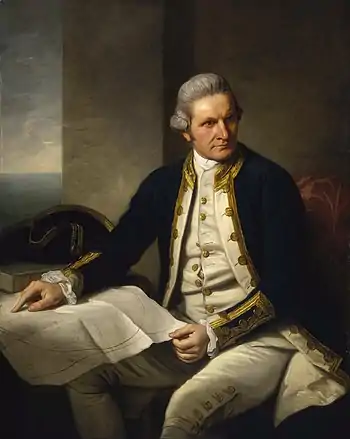HMS Grenville (1754)
HMS Grenville, was a schooner built in Marblehead, Massachusetts,[2] and originally named Sally. The ship was purchased and renamed Grenville (for the British Prime Minister George Grenville) by Thomas Graves, Governor of Newfoundland on 7 August 1763 in Newfoundland.[1] From 1763 to 1767 English surveyor and explorer James Cook commanded Grenville, his first independent command.[3] Each summer season he used the ship to survey the coasts of Newfoundland and Labrador, making detailed maps. The following year, 1768, he began his first circumnavigation of the world.
| History | |
|---|---|
| Name | Grenville |
| Launched | 1754 |
| Name | HMS Grenville |
| Fate | Broken up in March 1775 |
| General characteristics | |
| Tons burthen | 67 tons [1] |
| Armament | 12 guns[1] |
In 1770 Grenville brought troops to Tobago from Barbados and they, together with troops from Fort Granby, helped suppress a slave rebellion.[4]
The ship was broken up in March 1775.[5]
Citations
- Robson. Page 136
- Winfield (2007), p. 326.
- Marquardt, p.115
- Craton (2009), p. 155.
- Marquardt, p.33
References
- Craton, Michael (2009). Testing the Chains: Resistance to Slavery in the British West Indies. Cornell University Press. ISBN 978-0801412523.
- Karl Heinz Marquardt (2003). The Global Schooner: Origins, Development, Design and Construction, 1695-1845. US Naval Institute Press.
- Winfield, Rif (2007). British Warships in the Age of Sail 1714–1792: Design, Construction, Careers and Fates. Seaforth. ISBN 978-1844157006.
- John Robson (2009). Captain Cook’s War and Peace: The Royal Navy years, 1755-1768. Seaforth Publishing.
